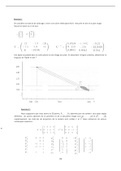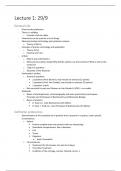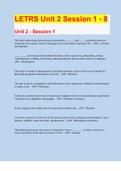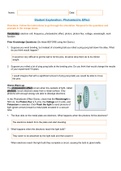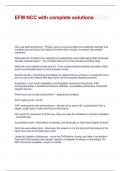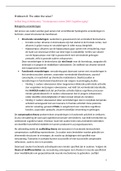Business Statistics - Cheat Sheet
Exam 8th October 2021 - Online
Exam stuff
● IQ question
● Probability → P( … ≤ X ≤ …) or P(X≤5)
● PMF, compute the expectation
● Confidence Interval, what does it mean
● Sample mean, sigma, what happens when increase/decrease
sigma
● Hypothesis questions
● Python code, answer what the solution could be
, Probability & Random Values
Sample space (Ω) = the set of all possible outcomes
Example Tossing a coin → Ω = {H, T}
Events (A) = subset of Ω.
Example Only heads → A = {H}
numbers of A
Formula Probability of an A = P = total number of Ω
● P( Ω)= 1, because Ω is a set of all possible outcomes
● P is always between 0 and 1
● If A ⊂ Ω → A is a subset of Ω
Random Value = a random number from one of the outcomes of a
random experiment.
Discrete RV = that takes only discrete, finite or at most
countably infinite number of values
● These values are counted
● Number of students attending in a class in a given day
● Number of customers in a store in a given day
● Number of clicks per hour
Continuous RV = can take on a continuum of values rather than
finite or countably finite numbers. They can take values in the
whole real number line or within a particular interval.
● These values are measured
● Height and weight
● Liters of milk produced by a cow
● Daily temperature
● Always estimate the P that it lies between two values
, Probability Distributions
Probability Distributions = gives information about the range of
values a random value can take and the probability taking a value
within a given range.
Discrete Distribution
Probability Mass Function (PMF) = determines the possibilities
of the different values in a graph.
Example Ω = {HHH, HHT, HTT, HTH, TTT, THH, TTH, THT, TTT}
Where X is the total number of H.
1
P(X=0) =
8
3
P(X=1) =
8
3
P(X=2) =
8
1
P(X=3) =
8
Binomial Distribution = when n independent fixed trials are
performed, and each trial ends in a success with probability p.
(failure with probability = 1 - p).
n!
Formula p( k)=P ( X =k )= ∗pk (1−p)n−k
k !(n−k ) !
● Number of trials (n) are fixed and completely independent of
each other
● Outcome is a success with probability p (or failure). The p of
success remains the same for every trial.
● RV X is the number of successes in n trials.
Example
Suppose you are a quality assurance inspector for your chip
producing company. From historic data it is known that the defect
rate of the chipsis 10%. You select 50 chips at random and
independently, what is the probability that exactly 10 will be
defective. Here,n= 50;k= 10;p= 0:12.
Example
The accuracy of taking orders at a drive-thru window is important for
a fast food chain business. Just imagine if the accuracy of taking
Exam 8th October 2021 - Online
Exam stuff
● IQ question
● Probability → P( … ≤ X ≤ …) or P(X≤5)
● PMF, compute the expectation
● Confidence Interval, what does it mean
● Sample mean, sigma, what happens when increase/decrease
sigma
● Hypothesis questions
● Python code, answer what the solution could be
, Probability & Random Values
Sample space (Ω) = the set of all possible outcomes
Example Tossing a coin → Ω = {H, T}
Events (A) = subset of Ω.
Example Only heads → A = {H}
numbers of A
Formula Probability of an A = P = total number of Ω
● P( Ω)= 1, because Ω is a set of all possible outcomes
● P is always between 0 and 1
● If A ⊂ Ω → A is a subset of Ω
Random Value = a random number from one of the outcomes of a
random experiment.
Discrete RV = that takes only discrete, finite or at most
countably infinite number of values
● These values are counted
● Number of students attending in a class in a given day
● Number of customers in a store in a given day
● Number of clicks per hour
Continuous RV = can take on a continuum of values rather than
finite or countably finite numbers. They can take values in the
whole real number line or within a particular interval.
● These values are measured
● Height and weight
● Liters of milk produced by a cow
● Daily temperature
● Always estimate the P that it lies between two values
, Probability Distributions
Probability Distributions = gives information about the range of
values a random value can take and the probability taking a value
within a given range.
Discrete Distribution
Probability Mass Function (PMF) = determines the possibilities
of the different values in a graph.
Example Ω = {HHH, HHT, HTT, HTH, TTT, THH, TTH, THT, TTT}
Where X is the total number of H.
1
P(X=0) =
8
3
P(X=1) =
8
3
P(X=2) =
8
1
P(X=3) =
8
Binomial Distribution = when n independent fixed trials are
performed, and each trial ends in a success with probability p.
(failure with probability = 1 - p).
n!
Formula p( k)=P ( X =k )= ∗pk (1−p)n−k
k !(n−k ) !
● Number of trials (n) are fixed and completely independent of
each other
● Outcome is a success with probability p (or failure). The p of
success remains the same for every trial.
● RV X is the number of successes in n trials.
Example
Suppose you are a quality assurance inspector for your chip
producing company. From historic data it is known that the defect
rate of the chipsis 10%. You select 50 chips at random and
independently, what is the probability that exactly 10 will be
defective. Here,n= 50;k= 10;p= 0:12.
Example
The accuracy of taking orders at a drive-thru window is important for
a fast food chain business. Just imagine if the accuracy of taking


